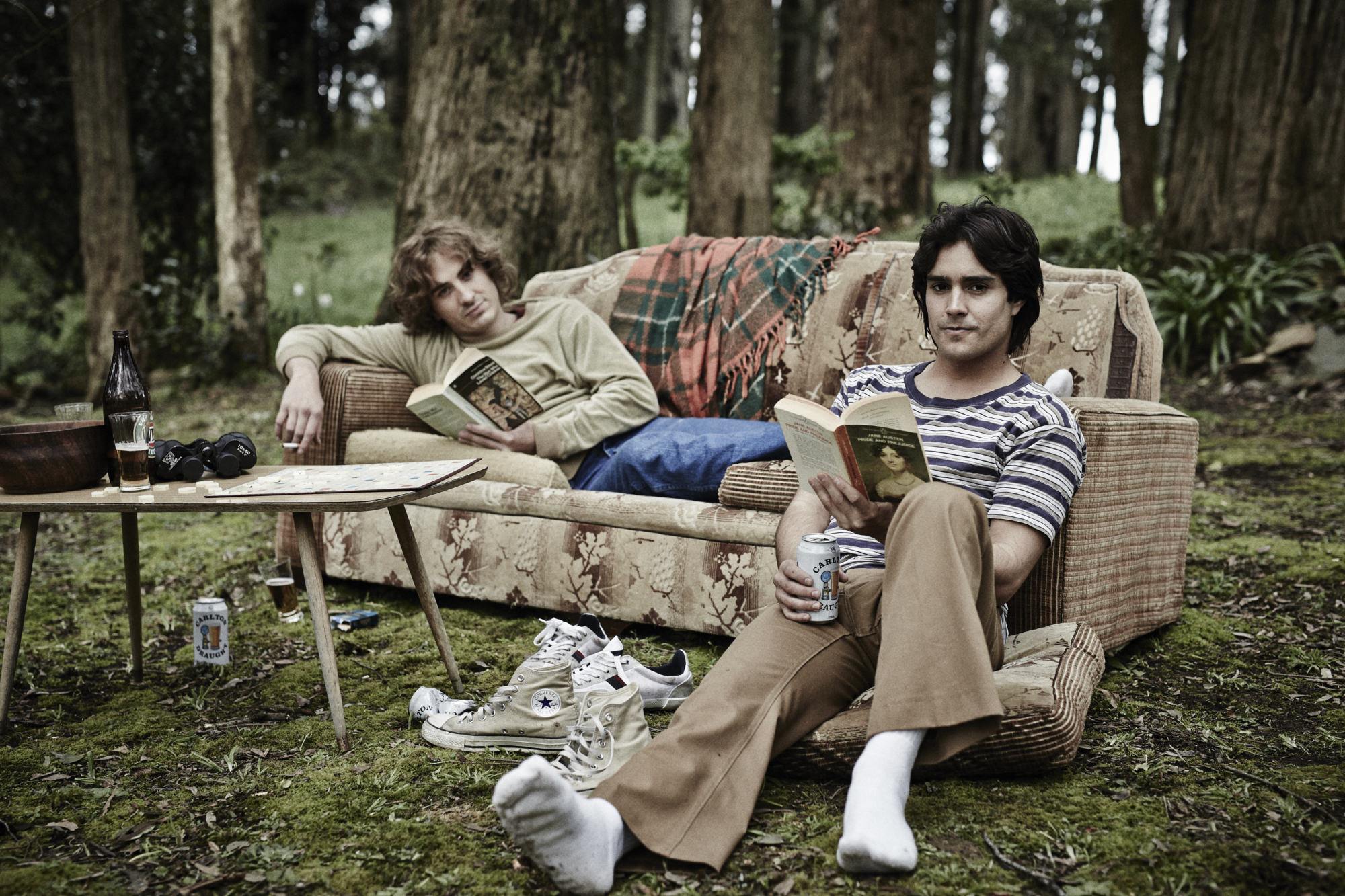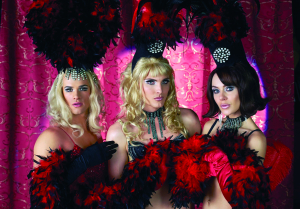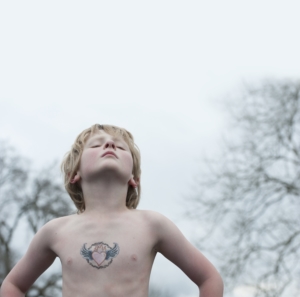When a certain, much-loved type of story becomes culturally iconic, it seems to undergo a process whereby the pressure applied to it swells alongside the significance attributed to it. There’s an added freight to becoming more broadly consequential: new resonances and hence new conflicts, a gravity and a burden that expand with the attachments of ever-increasing audiences.
Timothy Conigrave’s posthumous memoir Holding the Man is a story that’s been in the midst of such a swelling ever since it was published in 1995, not long after Conigrave died from AIDS-related illness. Now widely considered ‘one of the great love stories’,[1]David Berthold, ‘Holding the Man – A Personal Reflection’, Carving in Snow, 22 July 2012, <http://carveinsnow.blogspot.com.au/2012/07/holding-man.html>, accessed 27 August 2015. Berthold directed the first stage production of Holding the Man in November 2006. In 2005, as artistic director of Sydney’s Griffin Theatre, he commissioned Tommy Murphy to adapt the memoir. ‘essential queer reading’, ‘monumentally loved’ and ‘an Australian classic’,[2]Benjamin Law, ‘Holding the Man and AIDS in Australia’, The Wheeler Centre website, <http://www.wheelercentre.com/projects/the-long-view/holding-the-man-and-aids-in-australia>, accessed 27 August 2015. it has been reprinted fifteen times as well as adapted for the stage and, now, for the screen. The play, written by Tommy Murphy and originally performed by Sydney’s Griffin Theatre Company in 2006, was one of the most popular local theatrical productions of the last decade; the success of its six acclaimed seasons across Australia as well as productions in New Zealand, London’s West End and the US is quite extraordinary for an original, contemporary Australian play. The much-anticipated celluloid iteration, adapted again by Murphy and directed by celebrated Australian theatre and film director Neil Armfield, further inflates Holding the Man’s status. Thus far, its reception has been extremely warm. Around the time of its Australian theatrical release, Time Out wondered whether it could ‘be the new Priscilla – an Aussie gay story gone mainstream?’,[3]Nick Dent, ‘Holding the Man’, Time Out, <http://www.au.timeout.com/melbourne/film/654/holding-the-man>, accessed 27 August 2015; Dent is referring to the film The Adventures of Priscilla, the Queen of the Desert (Stephan Elliott, 1994). while on the Seven Network’s Sunrise program and elsewhere it was described as ‘Australia’s Brokeback Mountain’.[4]David Koch, ‘Oscar Buzz for Holding the Man’, Sunrise, Seven Network, 12 August 2015, <https://au.tv.yahoo.com/sunrise/video/watch/29240681/oscar-buzz-for-holding-the-man/>, accessed 27 August 2015; see also Garry Maddox, ‘Could Neil Armfield’s Holding the Man Be Australia’s Brokeback Mountain?’, The Sydney Morning Herald, 7 August 2015, <http://www.smh.com.au/entertainment/movies/could-neil-armfields-holding-the-man-be-australias-brokeback-mountain-20150804-gile7c.html>, accessed 27 August 2015. Koch and Maddox are citing Ang Lee’s 2005 film Brokeback Mountain. Meanwhile, the film’s official trailer encourages audiences to ‘discover the great Australian love story’.[5]Holding the Man official trailer, Transmission Films, available on YouTube, 21 June 2015, <https://www.youtube.com/watch?v=JOURNEMfHls>, accessed 27 August 2015.
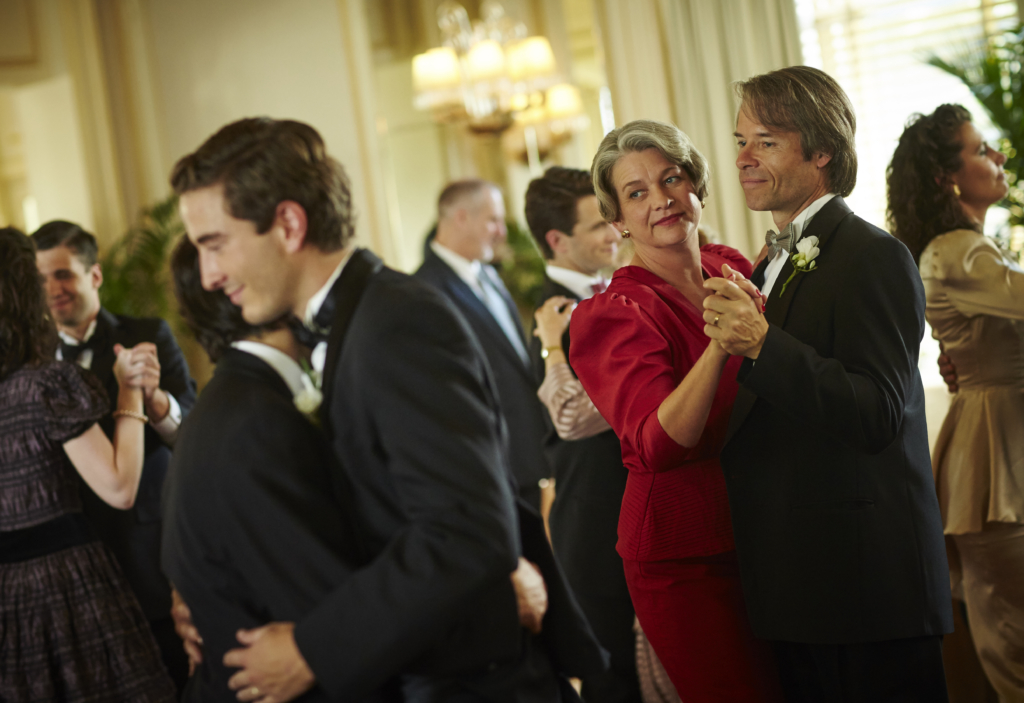
Holding the Man is undeniably our most popular gay love story; it’s hard to think of what else might even come close to being in the running. And it is certainly now our most visible national story about gay men and AIDS. Generations of Australian gay men, in particular, feel powerfully attached to it. As Stuart Richards has written, Holding the Man ‘has been a pivotal text in the formation of an Australian gay identity’.[6]Stuart Richards, ‘Holding the Man, and Bringing HIV/AIDS in Australia to a Mainstream Audience’, The Conversation, 10 August 2015, <http://theconversation.com/holding-the-man-and-bringing-hiv-aids-in-australia-to-a-mainstream-audience-43250>, accessed 27 August 2015. But what happens to a beloved local memoir on this trajectory towards national iconicity and with this far larger, likely international, audience? How much swelling in significance can a text handle before certain aspects of it are lost or obscured?
From page to stage to screen
Conigrave’s memoir is a sexually frank and plainly recalled account of his fifteen years with lover John Caleo, who died in the Fairfield Infectious Diseases Hospital on Australia Day in 1992. There are as many extraordinary elements to Conigrave and Caleo’s story as there are ordinary, relatable ones. One of the former is the fact that, despite all apparent odds, their relationship blossomed in 1976 at Xavier College, a Melbourne Jesuit school for boys, where Caleo was the captain of the football team, and Conigrave, an aspiring thesp. The mixed response to their relationship from peers, teachers and family, some of whom were tacitly or even outspokenly supportive, was itself remarkable. After graduation, Conigrave’s memoir describes the passage from high school to tertiary studies in the late 1970s, during which he became an actor, and Caleo, a chiropractor; their initiation into the curiosities and complexities of Melbourne’s and Sydney’s gay milieus of the early 1980s; and the latter half of that decade, by which time HIV/AIDS had become the dominant motif of gay life in those places, and in their own lives. Conigrave and Caleo were both diagnosed with HIV in 1985.
There are as many extraordinary elements to Conigrave and Caleo’s story as there are ordinary, relatable ones … despite all apparent odds, their relationship blossomed in 1976 at Xavier College, a Melbourne Jesuit school for boys, where Caleo was the captain of the football team, and Conigrave, an aspiring thesp.
The powerful response many readers have to Holding the Man is partly an effect of Conigrave’s intimate narrative voice. At times guileless and almost documentary, it is direct and uninhibited; the prose is unadorned, often embarrassingly or agonisingly raw – adolescent lust, relationship angst and world-exploding grief are all offered up with little self-adjudication. He finished the memoir as he was dying from AIDS-related illness and didn’t live to see its publication. Some accounts suggest he was battling AIDS-induced dementia while he was completing it.[7]See Richard Watts, ‘Holding the Man: From Page to Stage to Screen’, ArtsHub, 21 August 2015, <http://screen.artshub.com.au/news-article/features/film/richard-watts/holding-the-man-from-page-to-stage-to-screen-249027>, accessed 27 August 2015.
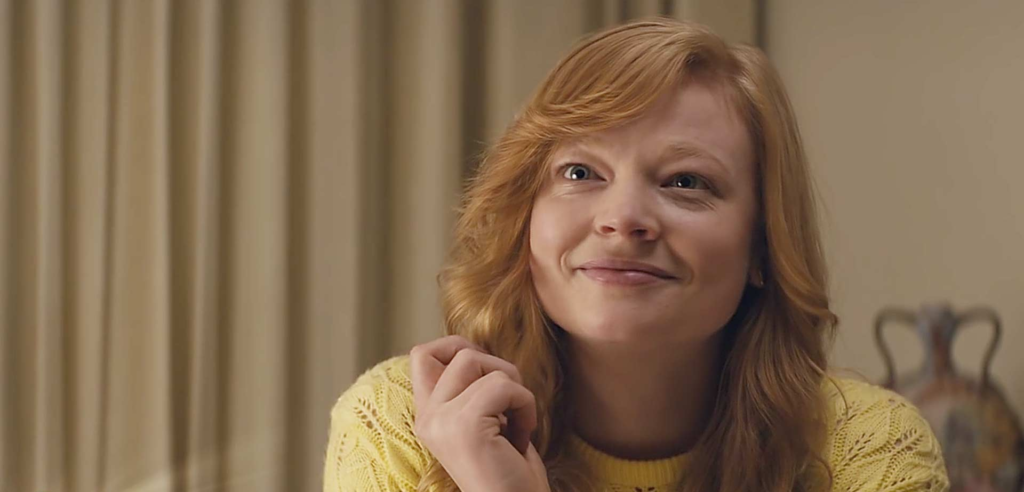
This is a book to which people are passionately attached. ‘The emotional journey it puts into words is vivid and immediate,’ Ben Neutze writes. ‘Conigrave lets you so deeply into his life that Tim and John start to feel like close friends.’[8]Ben Neutze, ‘Holding the Man and the Painful Laughter of Recognition’, Daily Review, 15 June 2015, <http://dailyreview.com.au/holding-the-man-and-the-painful-laughter-of-recognition/25369>, accessed 27 August 2015. Readers feel as though they know Conigrave and Caleo, and indeed many did know them. A well-thumbed copy of Holding the Man was lent to me by my first close gay male friend, Nick, around the year 2000. Ryan Corr, who plays Tim in the film, saw it on stage in Sydney at age seventeen.[9]Matthew Toomey, ‘Interview – Ryan Corr on Holding the Man’, The Film Pie, 24 August 2015, <http://www.thefilmpie.com/index.php/blog-2/3584-interview-ryan-corr-on-holding-the-man>, accessed 27 August 2015. Every Holding the Man reader seems to have their own story. A lot of gay men claim it altered their lives. But, with a book so widely adored, there are sensitivities in the processes of adaptation. Filmmaker Tony Ayres, a friend of Conigrave’s, attempted to translate Holding the Man into a screenplay almost two decades ago and concluded he was too close to its author to retell the story.[10]Watts, op. cit. Murphy has spoken about his longtime custodianship of the text and the process of adapting it for the stage, which, he says, emboldened him to write the screenplay. The first wave of theatre audiences were supportive and forgiving: ‘They were so helpfully forgetful of the detail of the book, or just embracing of its new shape,’ he recalls. ‘Knowing that was a really useful lesson for doing the screenplay.’[11]Tommy Murphy, ‘MIFF 2015 Talking Pictures: Holding the Man – Behind the Scenes’, available on YouTube, 11 August 2015, <https://www.youtube.com/watch?v=JWRa1yZfxV0>, accessed 27 August 2015. The success of the theatrical production acted as a barometer for the reception of new versions of Conigrave and Caleo’s story; it indicated that devotees of the book would accept some changes.
The film has other connections to the (queer) theatre world that go beyond its previous incarnation as a play, including some nods to the Australian performing-arts response to HIV/AIDS. Its central theatrical genealogy, of course, is Conigrave’s own work as a National Institute of Dramatic Art–trained actor and, later, as a theatre-maker who spearheaded the production of acclaimed HIV/AIDS-themed 1986 play Soft Targets. Both memoir and film provide accounts of his involvement in that project, and some Aussie theatregoers will recognise the legacies of that work in Armfield’s adaptation. For example, Luke Mullins plays a gay man living with HIV/AIDS in Sydney whom Tim interviews as part of his research for Soft Targets. Mullins wrestled with angels as Prior Walter in a reprisal of Angels in America by Sydney’s Belvoir St Theatre in 2013. Mitchell Butel and Marcus Graham, who were also in that production, play small roles in Armfield’s film, too. Alongside drawcard Australian favourites Guy Pearce, Geoffrey Rush and Anthony LaPaglia, the larger roster of Australian players with connections to the political, artistic and queer worlds Conigrave inhabited in Sydney and Melbourne gestures towards these legacies.
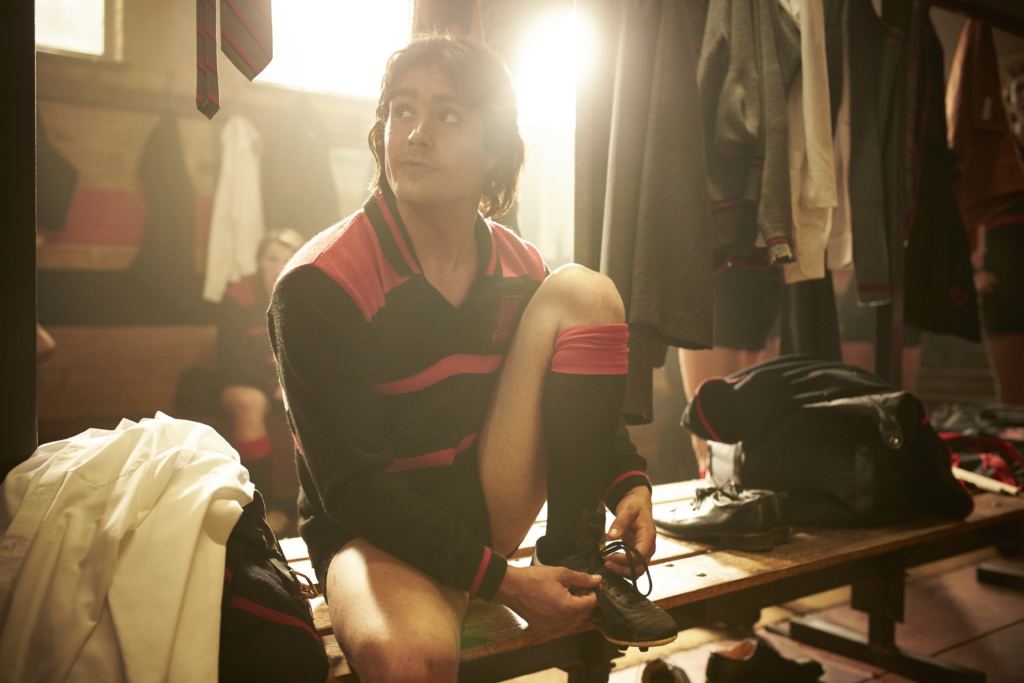
In spite of this theatrical heritage, the film doesn’t suffer from the dramatic staginess that some critics have alleged it does.[12]See, for example, Luke Buckmaster, ‘Holding the Man Review – Memorable Performances but a Little Wobbly’, The Guardian, 15 June 2015, <http://www.theguardian.com/film/2015/jun/15/holding-the-man-review-memorable-performances-but-a-little-wobbly>, accessed 27 August 2015. Holding the Man is Armfield’s first feature film since 2006’s Candy, starring Heath Ledger and Abbie Cornish, and some aspects of that film’s tonal quality are evident: pared-back dialogue and a realist production design of mostly domestic spaces that draw viewers inwards into the intimate precincts of lust, conflict, comfort and commitment. Armfield may be better known as a theatre director, but both films are sensuous and tactile despite their origins in first-person, interior narratives.
What the film more strongly resembles are depictions of recent national pasts in Australian cinema and TV that deploy the coming-of-age narrative to explore the intimate undercurrents of race, class and, especially, gender and sexuality in Australia. I’m thinking of the exploration of youthful femininities and masculinities in Jack Duigan’s The Year My Voice Broke (1987) and its sequel, Flirting (1991) – the latter of which is simultaneously a masterclass in bottled-up teen desire, both heterosexual and homosocial, and a stylistic ancestor to the sequences of Armfield’s Holding the Man that are set at Xavier College. The 1991 miniseries Brides of Christ and, later, with a sharper eye on the intersections of race and migration, Tony Ayres’ The Home Song Stories (2007) are other examples. These works all deconstruct dominant cultures of Australian intimacy by highlighting the collision of insider and outsider gazes. The innocence and knowingness simultaneously granted by the coming-of-age perspective allow these texts to draw out both the charm and the menace of these cultures, their nostalgic fascination alongside their brutal marginalisations. Carlotta (Samantha Lang, 2014) is another example that concentrates on the contemporary heritage of sex/gender outsiders, and there is something of the style and themes of this Australian subgenre in the 2014 miniseries sequel to The Devil’s Playground (Fred Schepisi, 1976).
Holding the Man is Armfield’s first feature film since 2006’s Candy … and some aspects of that film’s tonal quality are evident: pared-back dialogue and a realist production design of mostly domestic spaces that draw viewers inwards into the intimate precincts of lust, conflict, comfort and commitment.
The more recent of these films are subject to what might be called ‘the Puberty Blues effect’: a look and feel somewhat indebted to the 2012 TV adaptation of Kathy Lette and Gabrielle Carey’s iconic 1979 novel of the same name. Though Puberty Blues is allegedly fiction and Holding the Man is a memoir, the two books aren’t entirely dissimilar as source texts. They’re both iconic Australian coming-of-age stories written accessibly via a young person’s consciousness. They describe an attenuated but still lingering sex/gender order in the Australian east coast from, alternately, proto-feminist and gay-liberation perspectives. Teen larrikinism, in both adorable and revolting guises, and the undulations of sexual discovery give both stories narrative and generic form. There is also a shared production aesthetic. Holding the Man’s production design by Josephine Ford, who worked on Cut Snake (Tony Ayres, 2014) and Animal Kingdom (David Michôd, 2010), transports viewers to a soft-wash 1970s and 1980s Melbourne, and a killer soundtrack including Bronski Beat, T. Rex, The Masters Apprentices’ anthemic ‘Because I Love You’ and Bryan Ferry’s ‘Let’s Stick Together’ do the rest of the nostalgia work. Jason Di Rosso compares the film to ‘leafing through a photo album’:
Moments of a life leap off each page in vivid bursts. Catholic school in the late seventies, a family wedding, university in the 80s, the first tentative steps in a career, triumphs and tragedy.[13]Jason Di Rosso, ‘Holding the Man’, The Final Cut, ABC Radio National, 21 August 2015, transcript, <http://www.abc.net.au/radionational/programs/finalcut/holding-the-man/6712192>, accessed 27 August 2015.
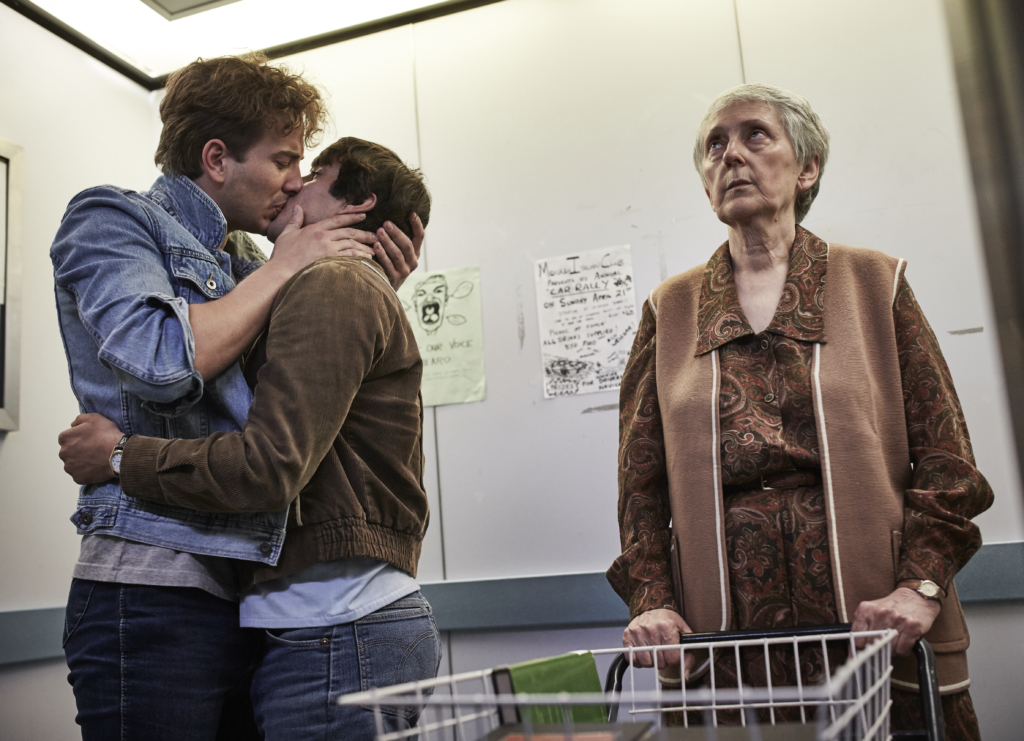
Dramatising AIDS
The first-wave experience of AIDS among mostly gay men is likewise now part of these recent histories. It is also increasingly the subject of a backwards-looking trend in Anglo-American screen works that includes TV productions like The Normal Heart (Ryan Murphy, 2014) and The Line of Beauty, Hollywood films like Dallas Buyers Club (Jean-Marc Vallée, 2013) and a string of documentaries, including We Were Here (David Weissman & Bill Weber, 2011) and How to Survive a Plague (David France, 2012). Yet, in the canon of Australian queer films – which surely includes The Sum of Us (Geoff Burton & Kevin Dowling, 1994), Head On (Ana Kokkinos, 1998) and everyone’s favourite, Priscilla – HIV/AIDS hasn’t featured much, apart from as a homophobic barb or a lurking subtextual spectre. Perhaps the exception, Ayres’ Walking on Water (2002) has always felt, to me, more like a film about the ambiguous consequences of a close friend’s untimely death rather than an ‘AIDS film’ per se: HIV is part of its narrative catalyst rather than a centrally explored theme. In this way, Holding the Man makes some redress for the absence of big-screen Australian stories about AIDS.
The protracted detail given to Caleo’s illness in the final quarter of Conigrave’s memoir is not all delivered in Armfield’s adaptation, but neither is the messy and devastating experience of dying from AIDS politely concealed. Part of the visual repertoire of the pre-antiretrovirals AIDS movie is the spectacle of the sick and dying body: an assortment of mysterious illnesses, extremely painful procedures, loss of privacy and polite bodily dignity, experimental treatments, Kaposi’s sarcoma, wasting, dementia. These are all present but, with Holding the Man, we’re now far away from the horror movies, moralistic melodramas and sci-fi medical thrillers of early American AIDS cinema. The hospital scenes aren’t flinching – but they aren’t gratuitous, either. John, played by Craig Stott, is ready for the relief death will offer some time before he stops breathing, with his parents at his side and his lover’s hand running through his hair.
Most unusual for a mainstream film about HIV/AIDS is Holding the Man’s bold dramatisation of sexual desire and practice post-diagnosis. Its predecessors have tended to sever HIV-positive characters from active sexual desire.
If we apply a kind of Bechdel Test to films about the gay experience of AIDS, it might include such questions as: Are the people living with HIV/AIDS (PLWHA) accorded agency or are they rescued by doctors, family members or heroic white men? (Holding the Man, 1; Dallas Buyers Club, 0). Is the spectacle of anal sex not tucked away in a shameful, barely visible closet in the narrative? (Holding the Man, 1; Philadelphia [Jonathan Demme, 1993], 0). Are PLWHA more than just sacrificial martyrs who die tragically, in order that the nuclear-family status quo may be restored? If the function of this hypothetical AIDS Bechdel Test is to re-envisage PLWHA and gay men as fully formed humans, Holding the Man passes with flying colours.
Most unusual for a mainstream film about HIV/AIDS is Holding the Man’s bold dramatisation of sexual desire and practice post-diagnosis. Its predecessors have tended to sever HIV-positive characters from active sexual desire, quarantining the embodied site of potential infection and the symbolic site of sexual shame. Part of this visual logic is the evacuation of erotic possibility from bodies once so spectacularly coded as erotic – gay bodies, already overloaded with sexual meanings. John, once captain of the football team, with an athletic body fetishised by a homosocial and homoerotic gaze, would seem to be a perfect case upon which to inflict this kind of moralising visual and narrative logic: a healthy, masculine, sexy body turns into a sick, deteriorating and feminised one. Armfield’s film rejects this logic in satisfying ways, including a genuinely sexy scene in which Tim and a very sick John fuck. John remains an object of the camera’s, Tim’s and our adoring gazes, despite the physical debilitations of his illness.
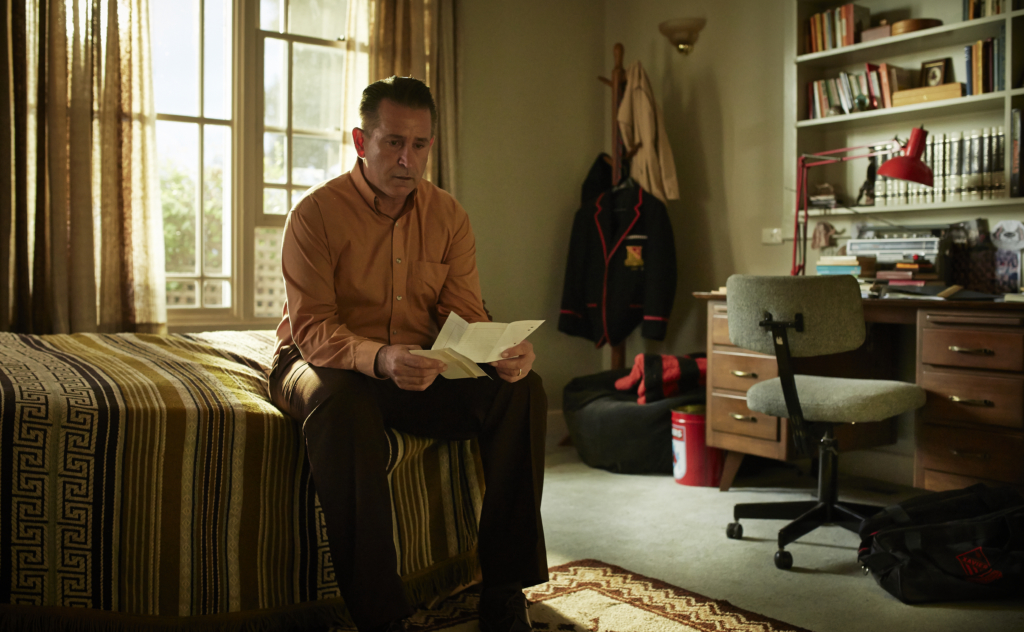
A universal struggle?
Coinciding with discussions about a potential referendum on the issue of same-sex marriage,[14]See Chris Uhlmann & Eliza Borrello, ‘Same-sex Marriage: Coalition Party Room in Favour of the Status Quo; No Conscience Vote on Gay Marriage’, ABC News, 11 August 2015, <http://www.abc.net.au/news/2015-08-11/same-sex-marriage-party-room-votes-in-favour-of-status-quo/6689678>, accessed 27 August 2015. the timing of Holding the Man’s release has wed the film to the current campaign for marriage equality, in spite of the historical anachronism involved in conflating these two stories. Connections may have happened inevitably, but this seems partly the consequence of deliberate decisions by distributor Transmission to cleave the film’s theatrical release to the ‘equal love’ campaign. For instance, Tim’s defiant line ‘he’s my husband’ features very prominently in the film’s trailer. Likewise, its official Twitter account, @HTMmovie, started a #PMforHTM hashtag exhorting Prime Minister Tony Abbott and other politicians resistant to marriage reform to see the film, and encouraged influential tweeters to get the message viral.
In fact, Holding the Man as ‘the great Australian love story’ has been offered in a similar manner to how same-sex marriage is marketed in the ‘equal love’ campaign: as universal. In an interview, producer Kylie du Fresne explained that ‘while [Holding the Man] is a great gay love story, ultimately it is just a great love story, regardless of gender’.[15]Kylie du Fresne, quoted in Javier Encalada, ‘Local Support for John and Tim’s Love Story’, The Northern Star, 17 August 2015, <http://www.northernstar.com.au/news/local-support-john-and-tims-love-story/2742971/>, accessed 27 August 2015. On Network Ten’s The Project, Meshel Laurie said, ‘It’s not [just] a gay story necessarily […] it’s a story about relationships, and love’.[16]Meshel Laurie, ‘Ryan Corr’, The Project, Network Ten, 7 August 2015, <http://tenplay.com.au/channel-ten/the-project/extra/season-7/ryan-corr>, accessed 26 August 2015. On Sunrise, David Koch commented that ‘it’s stories like this that connect to political decisions of the moment’, triggering an impassioned diatribe from actor Stott about the recalcitrance of Australian politicians in the face of popular sentiment on the gay-marriage issue.[17]Koch and Craig Stott, ‘Oscar Buzz for Holding the Man’, op. cit. Whether consciously or not, the apparent relevance of Conigrave and Caleo’s story as an object lesson for the importance of today’s marriage-equality lobby has been asserted in many arenas of the film’s reception. Gary Maddox’s review even describes the film as ‘discuss[ing] political action, the AIDS crisis and the battle for mainstream rights that underpins the current push for marriage equality’.[18]Gary Maddox, ‘Sydney Film Festival 2015 Review: Holding the Man Matches Humour with Devastation’, The Sydney Morning Herald, 14 June 2015, <http://www.smh.com.au/entertainment/movies/sydney-film-festival-2015-review-holding-the-man-matches-humour-with-devastation-20150615-ghntu6.html>, accessed 27 August 2015.
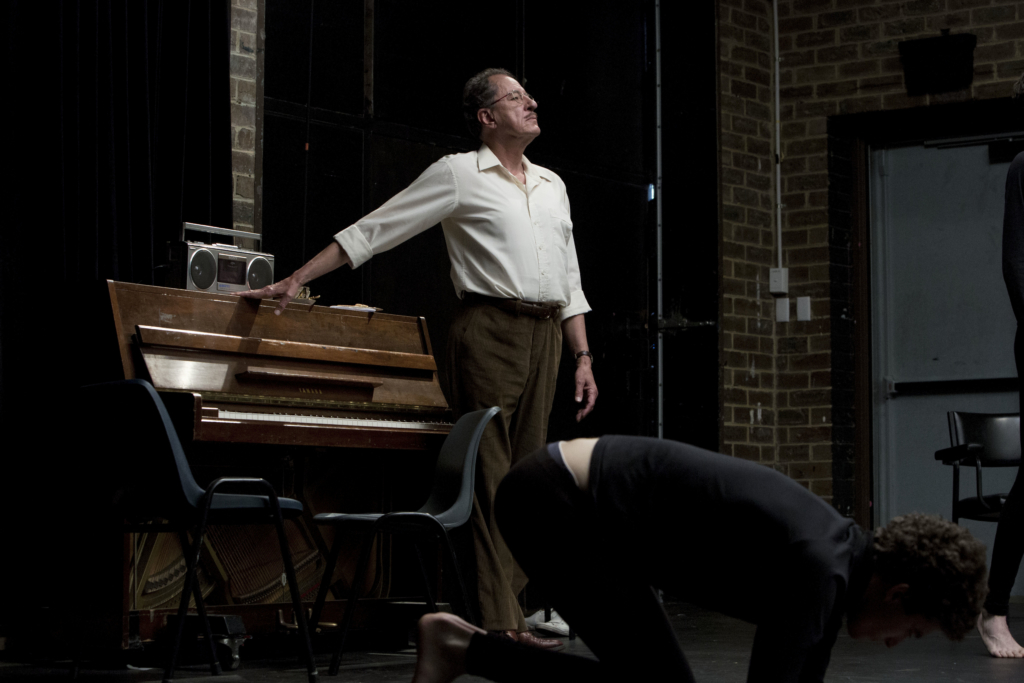
There are indeed ways in which the circumstances of the AIDS crisis (particularly regarding questions of inheritance and the legal status of same-sex partners) can be co-opted into a historical sequence building up to the emergence of marriage equality. Yet same-sex marriage was more than fifteen years away as a political idea when Caleo died. It was, moreover, extremely unlikely to have come up among the political queers he and Conigrave hung out with at Monash University’s GaySoc in the late 1970s. Incidentally, those issues of inheritance rights are far less relevant to the marriage-equality debate in Australia, where we have laws recognising de facto spousal rights. Hence, to recruit Conigrave and Caleo into the ‘equal love’ campaign is to awkwardly and retroactively shoehorn into their story a political paradigm that now burdens it with the hopes of a different moment in queer and Australian political history. It imposes the imprimatur of ‘universal’ love on a very particular story of gay romance and AIDS in the 1980s.
Whose story?
Holding the Man no longer quietly ‘belongs’ to those who read it when they were coming out in the 1990s, or to those who adapted it for the stage in the mid 2000s; the story has entered a larger Australian canon. As a text that has become iconic, albeit gradually and over two decades of reproduction and reception, it will inevitably be an Australian story with cultural afterlives well beyond its original memoir form. The passing of time has made Conigrave and Caleo’s story into a historical artefact as well as an index of a much larger archive of other people’s memories: coming-of-age stories; sexual-awakening stories; east-coast-Australia stories; stories of loss and survival, activism and art, community-infrastructure building and political organising; and, now, stories of gay marriage. Conigrave’s voice has come to stand in for the experience of a certain ‘generation’, with all the problems that such a designation implies, but also speaks far beyond that constituency, too. To those particular but universalisable experiences to which Holding the Man was already wed – ‘Melbourne in the 1980s’, ‘being gay in Australia’, ‘AIDS’, for example – we can now add ‘equal love’, for better or for worse.
Endnotes
| 1 | David Berthold, ‘Holding the Man – A Personal Reflection’, Carving in Snow, 22 July 2012, <http://carveinsnow.blogspot.com.au/2012/07/holding-man.html>, accessed 27 August 2015. Berthold directed the first stage production of Holding the Man in November 2006. In 2005, as artistic director of Sydney’s Griffin Theatre, he commissioned Tommy Murphy to adapt the memoir. |
|---|---|
| 2 | Benjamin Law, ‘Holding the Man and AIDS in Australia’, The Wheeler Centre website, <http://www.wheelercentre.com/projects/the-long-view/holding-the-man-and-aids-in-australia>, accessed 27 August 2015. |
| 3 | Nick Dent, ‘Holding the Man’, Time Out, <http://www.au.timeout.com/melbourne/film/654/holding-the-man>, accessed 27 August 2015; Dent is referring to the film The Adventures of Priscilla, the Queen of the Desert (Stephan Elliott, 1994). |
| 4 | David Koch, ‘Oscar Buzz for Holding the Man’, Sunrise, Seven Network, 12 August 2015, <https://au.tv.yahoo.com/sunrise/video/watch/29240681/oscar-buzz-for-holding-the-man/>, accessed 27 August 2015; see also Garry Maddox, ‘Could Neil Armfield’s Holding the Man Be Australia’s Brokeback Mountain?’, The Sydney Morning Herald, 7 August 2015, <http://www.smh.com.au/entertainment/movies/could-neil-armfields-holding-the-man-be-australias-brokeback-mountain-20150804-gile7c.html>, accessed 27 August 2015. Koch and Maddox are citing Ang Lee’s 2005 film Brokeback Mountain. |
| 5 | Holding the Man official trailer, Transmission Films, available on YouTube, 21 June 2015, <https://www.youtube.com/watch?v=JOURNEMfHls>, accessed 27 August 2015. |
| 6 | Stuart Richards, ‘Holding the Man, and Bringing HIV/AIDS in Australia to a Mainstream Audience’, The Conversation, 10 August 2015, <http://theconversation.com/holding-the-man-and-bringing-hiv-aids-in-australia-to-a-mainstream-audience-43250>, accessed 27 August 2015. |
| 7 | See Richard Watts, ‘Holding the Man: From Page to Stage to Screen’, ArtsHub, 21 August 2015, <http://screen.artshub.com.au/news-article/features/film/richard-watts/holding-the-man-from-page-to-stage-to-screen-249027>, accessed 27 August 2015. |
| 8 | Ben Neutze, ‘Holding the Man and the Painful Laughter of Recognition’, Daily Review, 15 June 2015, <http://dailyreview.com.au/holding-the-man-and-the-painful-laughter-of-recognition/25369>, accessed 27 August 2015. |
| 9 | Matthew Toomey, ‘Interview – Ryan Corr on Holding the Man’, The Film Pie, 24 August 2015, <http://www.thefilmpie.com/index.php/blog-2/3584-interview-ryan-corr-on-holding-the-man>, accessed 27 August 2015. |
| 10 | Watts, op. cit. |
| 11 | Tommy Murphy, ‘MIFF 2015 Talking Pictures: Holding the Man – Behind the Scenes’, available on YouTube, 11 August 2015, <https://www.youtube.com/watch?v=JWRa1yZfxV0>, accessed 27 August 2015. |
| 12 | See, for example, Luke Buckmaster, ‘Holding the Man Review – Memorable Performances but a Little Wobbly’, The Guardian, 15 June 2015, <http://www.theguardian.com/film/2015/jun/15/holding-the-man-review-memorable-performances-but-a-little-wobbly>, accessed 27 August 2015. |
| 13 | Jason Di Rosso, ‘Holding the Man’, The Final Cut, ABC Radio National, 21 August 2015, transcript, <http://www.abc.net.au/radionational/programs/finalcut/holding-the-man/6712192>, accessed 27 August 2015. |
| 14 | See Chris Uhlmann & Eliza Borrello, ‘Same-sex Marriage: Coalition Party Room in Favour of the Status Quo; No Conscience Vote on Gay Marriage’, ABC News, 11 August 2015, <http://www.abc.net.au/news/2015-08-11/same-sex-marriage-party-room-votes-in-favour-of-status-quo/6689678>, accessed 27 August 2015. |
| 15 | Kylie du Fresne, quoted in Javier Encalada, ‘Local Support for John and Tim’s Love Story’, The Northern Star, 17 August 2015, <http://www.northernstar.com.au/news/local-support-john-and-tims-love-story/2742971/>, accessed 27 August 2015. |
| 16 | Meshel Laurie, ‘Ryan Corr’, The Project, Network Ten, 7 August 2015, <http://tenplay.com.au/channel-ten/the-project/extra/season-7/ryan-corr>, accessed 26 August 2015. |
| 17 | Koch and Craig Stott, ‘Oscar Buzz for Holding the Man’, op. cit. |
| 18 | Gary Maddox, ‘Sydney Film Festival 2015 Review: Holding the Man Matches Humour with Devastation’, The Sydney Morning Herald, 14 June 2015, <http://www.smh.com.au/entertainment/movies/sydney-film-festival-2015-review-holding-the-man-matches-humour-with-devastation-20150615-ghntu6.html>, accessed 27 August 2015. |
